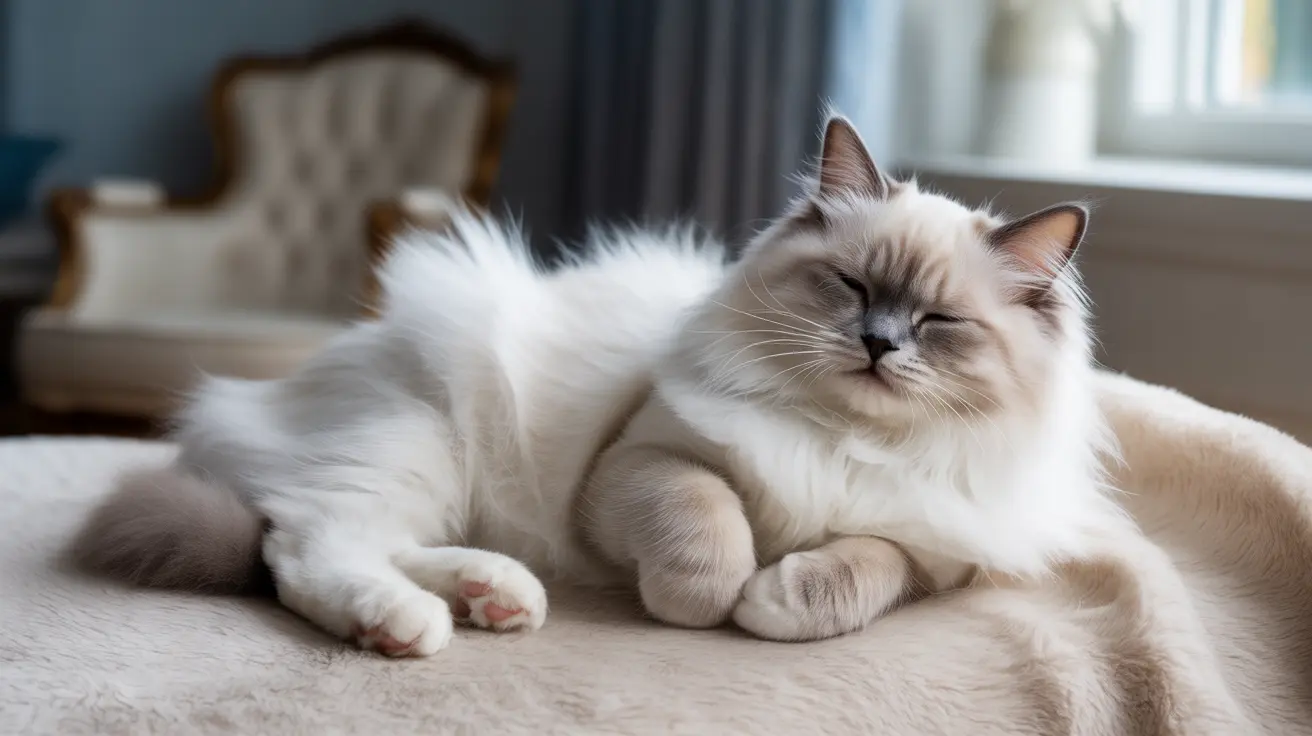Complete Cat Anesthesia Safety and Care Guide: Essential Preparation and Recovery Tips for Pet Owners
When your beloved feline companion requires a veterinary procedure involving anesthesia, it's natural to feel concerned about the risks and wonder how you can best support your cat through the experience. Modern veterinary anesthesia has become significantly safer over the years, with death rates in cats estimated at only 0.24%, but proper preparation and aftercare remain crucial for optimal outcomes. Understanding what to expect and how to prepare can make all the difference in ensuring your cat's safety and comfort throughout the entire process.
This comprehensive guide will walk you through everything you need to know about cat anesthesia safety and care, from pre-procedure preparation to post-operative recovery. Whether your cat is facing a routine spay/neuter surgery, dental cleaning, or more complex procedure, being well-informed about anesthesia protocols, potential risks, and proper care techniques will help you advocate for your pet's wellbeing and provide the best possible support during their recovery.
Understanding Cat Anesthesia: Types and Modern Safety Standards
Anesthesia is accomplished by administering drugs that depress nerve function, with the word itself coming from the Greek meaning "lack of sensation." For cats, veterinarians have several anesthetic options depending on the procedure and your pet's specific needs.
Types of Anesthesia Used in Cats
General anesthesia causes unconsciousness, muscular relaxation, and complete loss of pain sensation for a short period. This is typically achieved through a balanced approach combining sedatives, analgesics, and induction agents tailored to your cat's individual requirements. An endotracheal tube is inserted into the windpipe to deliver anesthetic gases like isoflurane or sevoflurane along with oxygen, while also preventing aspiration.
Other anesthetic types include local anesthesia using drugs like lidocaine or bupivacaine to numb specific areas, and sedation with medications such as acepromazine, midazolam, or dexmedetomidine to reduce anxiety while keeping cats conscious and mobile. For short procedures, immobilization drugs like ketamine or telazol may be used to restrict movement and provide pain relief without requiring intubation.
Current Safety Statistics and Risk Assessment
Recent studies show that anesthetic death risk in cats is approximately 0.24%, which represents a significant improvement in veterinary anesthesia safety. However, about 1 in 100,000 animals might still experience harmful reactions ranging from mild injection-site swelling to more serious complications like anaphylactic shock. The key factor in minimizing these risks lies in proper preparation, monitoring, and individualized anesthetic protocols.
Essential Pre-Anesthesia Preparation for Your Cat
Proper preparation before anesthesia is absolutely critical for your cat's safety. The most important step is following fasting guidelines, as cats should have food withheld for 6-12 hours before the procedure to reduce the risk of aspiration pneumonia. When cats are under anesthesia, they lose their swallowing reflex, and if vomiting occurs, stomach contents could enter the lungs causing serious complications.
Medical History and Health Assessment
Your veterinarian will need a complete medical history including all medications, supplements, pre-existing conditions, and any previous anesthetic experiences. This information helps identify potential risk factors and allows the veterinary team to customize the anesthetic protocol for your cat's specific needs. Vaccine status and reproductive history are also relevant factors in anesthetic planning.
Pre-surgical examinations, blood and urine tests, and sometimes radiographs can detect underlying conditions like heart, liver, or kidney diseases, diabetes, anemia, dehydration, or infections that increase anesthesia risks. Blood tests significantly increase the chance of detecting hidden problems, while chest x-rays and electrocardiograms are especially recommended for older cats who may have undiagnosed health issues.
Special Considerations for High-Risk Cats
Certain breeds face higher anesthesia risks due to anatomical factors. Brachycephalic cats like Persians and Himalayans may experience airway difficulties due to their flat facial structure. Additionally, about 0.9%-2.0% of cats may develop kidney dysfunction days after anesthesia, making pre-anesthetic kidney function assessment particularly important for older cats or those with existing health concerns.
Managing Anxiety and Stress Before Veterinary Procedures
Reducing stress before anesthesia not only improves your cat's overall experience but also contributes to safer anesthetic outcomes. Stressed cats may require higher doses of anesthetic drugs and can experience more complications during recovery.
Pre-Visit Sedation Options
For extremely anxious cats, your veterinarian may prescribe sedatives to be given before travel to the clinic. Medications like gabapentin can be administered as a pre-visit treatment to reduce stress and make handling easier. However, these medications should only be used under veterinary guidance and with proper timing to avoid interactions with anesthetic drugs.
Environmental and Handling Techniques
Feline-friendly handling techniques and environmental modifications can significantly reduce stress. Using pheromone sprays in carriers, maintaining quiet environments, and gentle handling all contribute to a calmer experience. Some veterinary clinics now offer separate cat-only areas or cat-friendly certification to minimize stress during visits.
The Anesthetic Procedure: What Happens During Surgery
Understanding what occurs during your cat's anesthetic procedure can help alleviate anxiety and prepare you for what to expect. The process begins with your cat being weighed and receiving a thorough pre-anesthetic examination including assessment of the chest, abdomen, and gums.
Intravenous Access and Fluid Therapy
IV catheter placement before anesthesia provides immediate access for fluid and emergency drug administration. IV fluids help maintain blood pressure, replace lost fluids, dilute anesthetics, and enhance metabolism and elimination of drugs from your cat's system. Cats receiving IV fluids generally recover faster and experience fewer complications. The recommended fluid maintenance rate for healthy adult cats is 3 ml/kg/h of balanced crystalloid solution.
Comprehensive Monitoring Throughout the Procedure
Modern veterinary anesthesia involves extensive monitoring to ensure your cat's safety throughout the procedure. A dedicated surgery assistant monitors your cat continuously, adjusting anesthesia levels as needed. Multiple monitoring devices track various vital parameters:
- Electrocardiogram (ECG) tracks heart rate and detects dangerous arrhythmias
- Blood pressure monitors measure both systolic and diastolic pressures
- Pulse oximeter measures blood oxygen levels and pulse rate
- Core body temperature probes prevent dangerous temperature fluctuations
- End-tidal CO2 monitors assess ventilation adequacy
- Respirometer counts breaths per minute
Vital signs are recorded at least every 15 minutes throughout the procedure, with many veterinary teams monitoring even more frequently. This comprehensive approach allows immediate detection and correction of any problems that may arise.
Critical Recovery Phase: The First Hours After Anesthesia
The recovery period represents the highest risk time for anesthetic complications, with sixty percent of anesthesia-related deaths in cats occurring during recovery, particularly within the first three hours. This makes vigilant monitoring during the initial recovery phase absolutely essential.
Immediate Post-Anesthetic Monitoring
Monitoring during recovery should be as intensive as during the anesthetic procedure itself. Parameters that require continuous assessment include heart rate, pulse quality, respiratory rate and pattern, oxygenation levels, blood pressure, and body temperature. This monitoring continues until all vital signs normalize and your cat demonstrates appropriate responsiveness.
Common recovery complications can include dysphoria (confusion and disorientation), emergence delirium, airway obstruction, low blood oxygen levels, and prolonged recovery times. Veterinary staff are trained to recognize these issues and intervene promptly with appropriate treatments, which may include sedatives, reversal agents, or additional supportive care.
Home Care During the Recovery Period
Once your cat is stable enough to go home, your role in providing proper aftercare becomes crucial for a smooth recovery. Many cats remain sleepy or tired for 12 to 24 hours after anesthesia, and this is completely normal. However, you should monitor your cat closely during this period, as unusual sluggishness or difficulty arousing your cat requires immediate veterinary consultation.
Creating an Optimal Recovery Environment
Provide a quiet, warm, and dim environment for your cat's recovery. Cats can experience difficulty regulating body temperature after anesthesia, so maintaining warmth is essential. Set up a comfortable area away from stairs, high surfaces, or other hazards where your cat might injure themselves while still affected by residual anesthetic effects.
Your cat should be separated from other animals for several days after surgery to prevent conflicts and protect surgical sites. This isolation period also makes it easier to monitor eating, drinking, and elimination patterns, which are important indicators of recovery progress.
Feeding and Hydration Guidelines
Water can typically be offered once your cat is fully awake and showing normal swallowing reflexes. Start with small amounts to ensure your cat can drink without difficulty. Food is usually withheld until the day after surgery, allowing the digestive system to recover fully from the anesthetic effects. When you do resume feeding, offer small portions of your cat's regular diet unless your veterinarian provides specific dietary instructions.
Activity Restrictions and Monitoring
Restrict your cat's activity level to prevent injury during the initial recovery period. Jumping, running, and rough play should be limited until your veterinarian clears normal activity, typically after suture removal or wound healing. Monitor your cat's behavior carefully, watching for signs of pain, infection, or other complications that might require veterinary attention.
Recognizing Anesthesia Complications at Home
While serious complications are rare, being able to recognize warning signs can be life-saving. Contact your veterinarian immediately if you notice any of these concerning symptoms:
- Extreme lethargy or inability to wake your cat appropriately
- Difficulty breathing or abnormal breathing patterns
- Pale or blue-tinged gums
- Vomiting or inability to keep water down
- Seizures or abnormal neurological signs
- Severe swelling at surgical sites or injection areas
- Refusal to eat or drink for more than 24 hours post-surgery
Other warning signs include persistent vocalization that seems pain-related, hiding behavior that's unusual for your cat, or any dramatic change in personality or responsiveness. Trust your instincts as a pet owner – if something seems wrong, it's always better to contact your veterinarian for guidance.
Long-term Recovery and Follow-up Care
Complete recovery from anesthesia typically occurs within several hours to a day, depending on the specific medications used and your cat's individual response. However, surgical site healing and return to full normal activity may take several weeks depending on the procedure performed.
Wound Care and Medication Management
Your veterinarian will provide specific instructions for wound care if your cat had surgery. This may include keeping surgical sites clean and dry, preventing licking or scratching, and monitoring for signs of infection such as increased swelling, discharge, or heat around the incision site. Some cats may require an Elizabethan collar to prevent self-trauma to healing tissues.
Administer all prescribed medications exactly as directed, including pain medications and antibiotics. Pain management is crucial not only for comfort but also for proper healing and recovery. Don't discontinue medications early even if your cat seems comfortable, as this can lead to breakthrough pain or incomplete treatment of infections.
Scheduled Follow-up Appointments
Attend all scheduled follow-up appointments with your veterinarian. These visits allow assessment of healing progress, suture removal when appropriate, and early detection of any developing complications. Your veterinarian will also provide guidance on when normal activity levels can be resumed and what long-term care considerations may apply.
Communication with Your Veterinary Team
Effective communication with your veterinarian about anesthesia risks and protocols is essential for optimal outcomes. Don't hesitate to ask questions about the specific anesthetic plan for your cat, monitoring procedures that will be used, and what to expect during recovery.
Questions to Ask Your Veterinarian
Important topics to discuss include your cat's individual risk factors, the specific drugs that will be used, monitoring equipment available, pain management protocols, and detailed aftercare instructions. Ask about emergency contact information and what constitutes a true emergency requiring immediate attention versus normal recovery variations.
If your cat has had previous anesthetic experiences, share details about how your cat responded, including any complications or unusual reactions. This historical information helps veterinarians customize protocols and anticipate potential issues.
Alternatives and Emerging Practices in Veterinary Anesthesia
While general anesthesia remains necessary for many procedures, veterinary medicine continues to evolve with new techniques and alternatives that may be appropriate in certain situations. Local anesthesia combined with sedation can sometimes replace general anesthesia for minor procedures, reducing overall risk while still ensuring patient comfort.
Advances in monitoring technology, new anesthetic drugs with better safety profiles, and improved understanding of feline physiology continue to make anesthesia safer. Some practices now offer consultation with veterinary anesthesia specialists for high-risk cases or use tele-consulting services to access expert guidance when needed.
Frequently Asked Questions
How long should my cat fast before anesthesia?
Cats should typically fast for 6-12 hours before anesthesia to reduce the risk of aspiration pneumonia. However, recent research suggests that shorter fasting periods with a small meal may actually reduce gastroesophageal reflux in some cases. Water is usually allowed until premedication begins. Always follow your specific veterinarian's instructions, as fasting recommendations may vary based on your cat's age, health status, and the planned procedure.
What are the signs that my cat is having an adverse reaction to anesthesia?
Warning signs include extreme lethargy or inability to wake your cat appropriately, difficulty breathing or abnormal breathing patterns, pale or blue-tinged gums, persistent vomiting, seizures, severe swelling at injection sites, or any dramatic behavioral changes. Contact your veterinarian immediately if you notice any of these symptoms, as prompt intervention can be critical for your cat's safety.
Is anesthesia more dangerous for older cats?
Age itself doesn't significantly increase anesthesia risk, but older cats are more likely to have underlying health conditions that can complicate anesthesia. Pre-anesthetic blood work, ECGs, and thorough physical examinations are especially important for senior cats to identify hidden problems like kidney disease, heart conditions, or hyperthyroidism that could increase risk. With proper evaluation and monitoring, many older cats undergo anesthesia safely.
Can I give my anxious cat something to calm them before the vet visit?
Pre-visit medications like gabapentin can be very helpful for anxious cats, but these should only be used under veterinary guidance. Your veterinarian needs to know about any medications given before anesthesia to avoid drug interactions and ensure proper anesthetic dosing. Contact your vet in advance to discuss anti-anxiety options rather than using over-the-counter products or human medications.
How long will my cat be groggy after anesthesia?
Most cats remain sleepy or tired for 12-24 hours after anesthesia, with normal behavior typically returning within several hours to a day depending on the specific medications used. Factors like age, health status, length of procedure, and individual sensitivity can affect recovery time. While some grogginess is expected, your cat should still be arousable and responsive. Contact your veterinarian if your cat seems excessively lethargic or difficult to wake.
What should I do if my cat won't eat or drink after coming home from surgery?
It's normal for cats to have reduced appetite for the first 24 hours after anesthesia. Offer small amounts of water once your cat is fully awake, and wait until the next day to offer food unless instructed otherwise. If your cat refuses all food and water for more than 24 hours, or shows signs of dehydration like dry gums or lethargy, contact your veterinarian as this may require medical intervention.
Are certain cat breeds at higher risk for anesthesia complications?
Brachycephalic breeds like Persians and Himalayans face higher anesthesia risks due to their flat facial structure, which can cause airway management challenges. These cats require special attention to airway placement and monitoring during anesthesia. Other breed-specific considerations may include genetic predispositions to certain heart conditions or drug sensitivities, which is why providing a complete medical and family history to your veterinarian is important.
Conclusion
Understanding cat anesthesia safety and proper care protocols empowers you to be an active partner in your pet's healthcare journey. While anesthesia always carries some inherent risks, modern veterinary practices, comprehensive monitoring, and evidence-based protocols have made procedures significantly safer than ever before. The key to optimal outcomes lies in thorough preparation, open communication with your veterinary team, and diligent aftercare during the critical recovery period.
By following pre-anesthetic fasting guidelines, providing complete medical histories, creating appropriate recovery environments, and monitoring for potential complications, you can help ensure your cat has the safest possible anesthetic experience. Remember that your observations as a pet owner are valuable – don't hesitate to contact your veterinary team with questions or concerns throughout the process. With proper preparation and care, your feline companion can safely navigate anesthetic procedures and return to their normal, healthy lifestyle.






